
The cheetah is a large cat with a tawny to creamy white or pale buff fur that is marked with evenly spaced, solid black spots. Its head is small and rounded, with a short snout and black tear-like facial streaks. It reaches 67–94 cm (26–37 in) at the shoulder, and the head-and-body length is between 1.1 and 1.5 m. Adults weigh between 21 and 72 kg. It is the fastest land animal, capable of running at 80 to 98 km/h ; it has evolved specialized adaptations for speed, including a light build, long thin legs and a long tail.

Acinonyx is a genus within the Felidae family. The only living species of the genus, the cheetah, lives in open grasslands of Africa and Asia.
The term "big cat" is typically used to refer to any of the five living members of the genus Panthera, namely the tiger, lion, jaguar, leopard, and snow leopard, as well as the non-pantherine cheetah and cougar.
A purr or whirr is a tonal fluttering sound made by some species of felids, including both larger, outdoor cats and the domestic cat, as well as two species of genets. It varies in loudness and tone among species and in the same animal. In smaller and domestic cats it is known as a purr, while in larger felids, such as the panther, it is called a whirr.
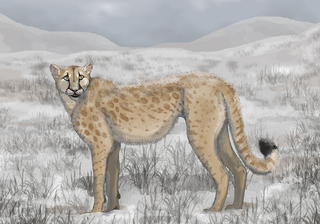
Miracinonyx is an extinct genus of felids belonging to the subfamily Felinae that was endemic to North America from the Pleistocene epoch and morphologically similar to the modern cheetah, although its apparent similar ecological niches have been considered questionable due to anatomical morphologies of the former that would have crippled any ability to run as fast. The genus was originally known from fragments of skeletons, but nearly complete skeletons have been recovered from Natural Trap Cave in northern Wyoming.

The Pantherinae is a subfamily of the Felidae; it was named and first described by Reginald Innes Pocock in 1917 as only including the Panthera species. The Pantherinae genetically diverged from a common ancestor between 9.32 to 4.47 million years ago and 10.67 to 3.76 million years ago.

A cursorial organism is one that is adapted specifically to run. An animal can be considered cursorial if it has the ability to run fast or if it can keep a constant speed for a long distance. "Cursorial" is often used to categorize a certain locomotor mode, which is helpful for biologists who examine behaviors of different animals and the way they move in their environment. Cursorial adaptations can be identified by morphological characteristics, physiological characteristics, maximum speed, and how often running is used in life. There is much debate over how to define a cursorial animal specifically. The most accepted definitions include that a cursorial organism could be considered adapted to long-distance running at high speeds or has the ability to accelerate quickly over short distances. Among vertebrates, animals under 1 kg of mass are rarely considered cursorial, and cursorial behaviors and morphology are thought to only occur at relatively large body masses in mammals. There are a few mammals that have been termed "micro-cursors" that are less than 1 kg in mass and have the ability to run faster than other small animals of similar sizes.
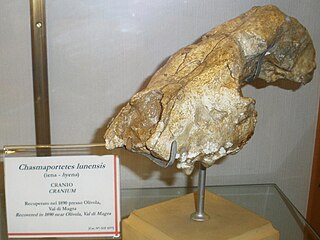
Chasmaporthetes, also known as hunting or running hyena, is an extinct genus of hyenas distributed in Eurasia, North America, and Africa during the Pliocene-Pleistocene epochs, living from 4.9 million to 780,000 years ago, existing for about 4.12 million years. The genus probably arose from Eurasian Miocene hyenas such as Thalassictis or Lycyaena, with C. borissiaki being the oldest known representative. The species C. ossifragus was the only hyena to cross the Bering land bridge into the Americas, and ranged over what is now Arizona and Mexico during Blancan and early Irvingtonian Land Mammal ages, between 5.0 and 1.5 million years ago.
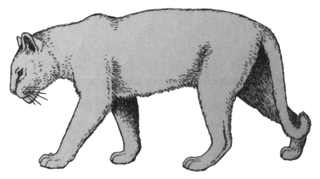
Panthera gombaszoegensis, also known as the European jaguar, is a Panthera species that lived from about 2.0 to 0.35 million years ago in Europe. The first fossils were excavated in 1938 in Gombasek, Slovakia.
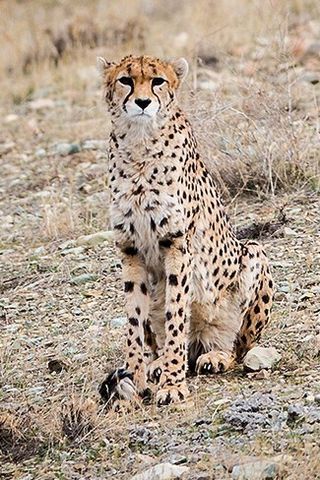
The Asiatic cheetah is a critically endangered cheetah subspecies currently only surviving in Iran. Its range once spread from the Arabian Peninsula and the Near East to the Caspian region, Transcaucasus, Kyzylkum Desert and northern South Asia, but was extirpated in these regions during the 20th century. The Asiatic cheetah diverged from the cheetah population in Africa between 32,000 and 67,000 years ago.

The Northwest African cheetah, also known as the Saharan cheetah, is a cheetah subspecies native to the Sahara and the Sahel. It is listed as Critically Endangered on the IUCN Red List. In 2008, the population was suspected to number less than 250 mature individuals.

Acinonyx pardinensis, sometimes called the Giant cheetah, is an extinct felid species belonging to the genus Acinonyx, closely related to the cheetah, native to Eurasia during the Pliocene and Pleistocene epochs. It was substantially larger than the living cheetah.

"Acinonyx kurteni", or the Linxia cheetah, is a discredited fossil specimen of an extinct cheetah discovered in China. The scientific name was assigned for the skull that was originally described to be that of an extinct species of cheetah, endemic to Asia during the Late Pliocene sub-epoch. It was estimated to have lived around 2.2 to 2.5 Ma BP, existing for approximately 0.3 million years.
Helicobacter acinonychis is a bacterium in the Helicobacteraceae family, Campylobacterales order. It was first isolated from cheetahs with gastritis, so has been associated with this disease in this particular species and others of its kind. It is Gram-negative, spiral-shaped, and grows under microaerophilic conditions. The type strain is 90-119.
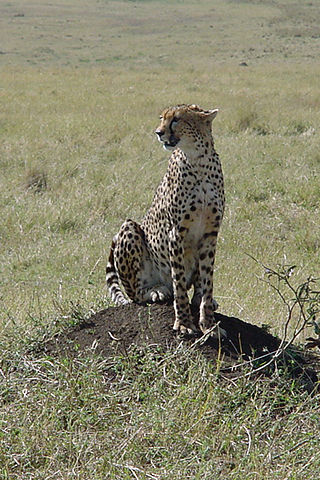
The East African cheetah, is a cheetah population in East Africa. It lives in grasslands and savannas of Tanzania, Kenya, Uganda and Somalia. The cheetah inhabits mainly the Serengeti ecosystem, including Maasai Mara, and the Tsavo landscape.

The European dhole was a paleosubspecies of the dhole, which ranged throughout much of Western and Central Europe during the Middle and Late Pleistocene. Like the modern Asiatic populations, it was a more progressive form than other prehistoric members of the genus Cuon, having transformed its lower molar tooth into a single cusped slicer. It was virtually indistinguishable from its modern counterpart, save for its greater size, which closely approached that of the gray wolf.

The Northeast African cheetah is a cheetah subspecies occurring in Northeast Africa. Contemporary records are known in South Sudan and Ethiopia, but population status in Eritrea, Djibouti, Somalia and Sudan is unknown.

The Southeast African cheetah is the nominate cheetah subspecies native to East and Southern Africa. The Southern African cheetah lives mainly in the lowland areas and deserts of the Kalahari, the savannahs of Okavango Delta, and the grasslands of the Transvaal region in South Africa. In Namibia, cheetahs are mostly found in farmlands. In India, four cheetahs of the subspecies are living in Kuno National Park in Madhya Pradesh after having been introduced there.
Sivapanthera is a prehistoric genus of felid described by Kretzoi in 1929. Species of Sivapanthera are closely related to the modern cheetah but differ from modern cheetahs by having relatively longer brain cases, flatter foreheads, narrower nostrils and larger teeth. In many ways, skulls of Sivapanthera show similarity to that of the puma, or even those of Panthera. Scholars differ on the validity of this genus, while some think that it should be treated as a distinct genus, others think that its members should be treated as members of the Acinonyx genus, or even as subspecies of Acinonyx pardinensis.
Sivapardus is an extinct, little-known genus of feline with only one species assigned to it, Sivapardus punjabiensis. It was described in 1969 by the paleontologist Abu Bakr based on a partial mandible from the Upper Siwaliks in Pakistan; the locality it was found at is estimated to be from the Late Pliocene to Early Pleistocene. S. punjabiensis was a large cat with a short and broad snout that may have lived on open grasslands.














